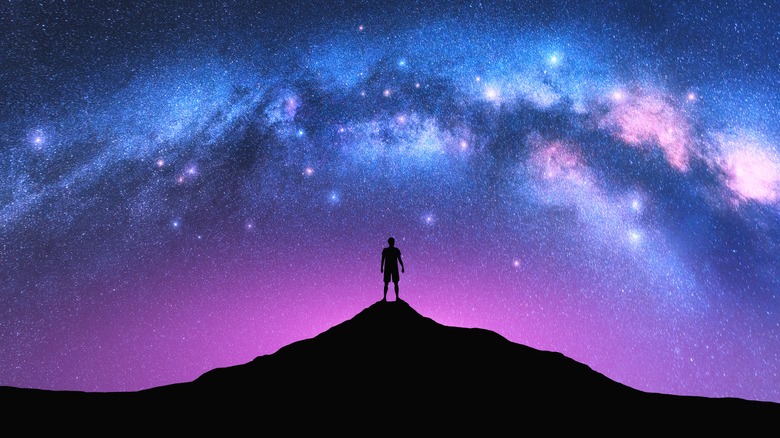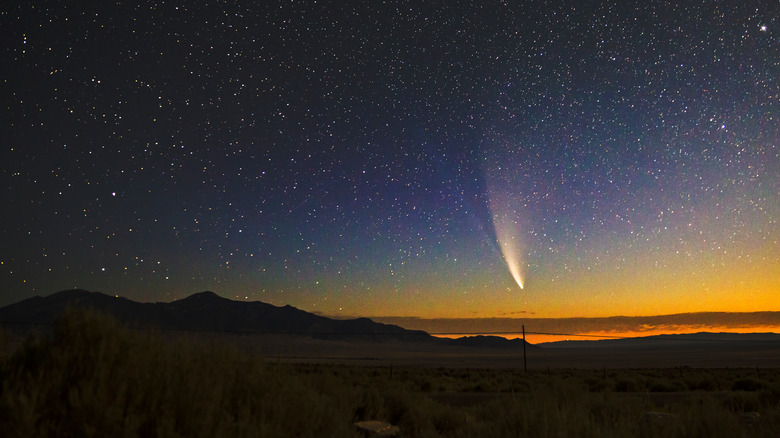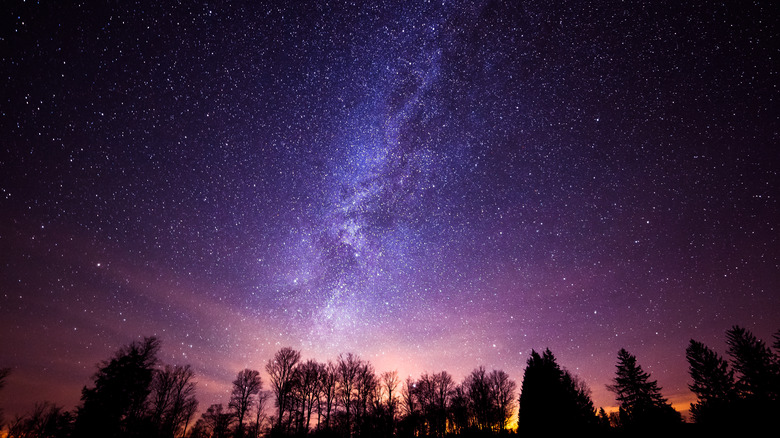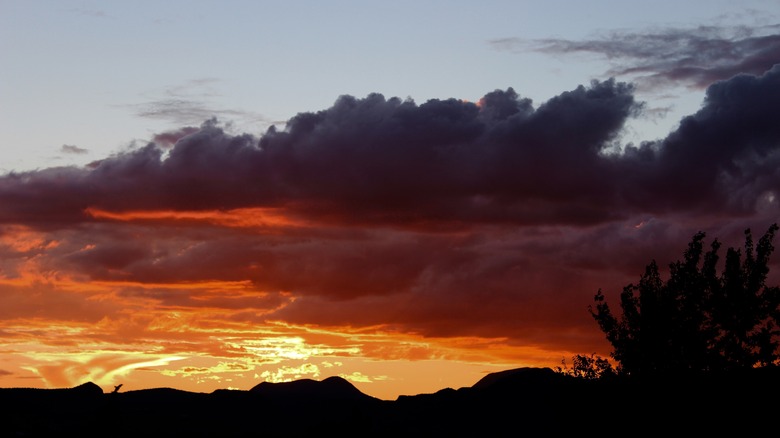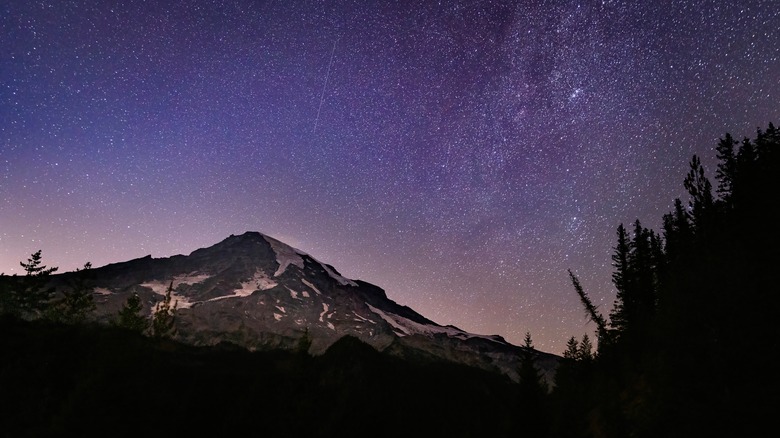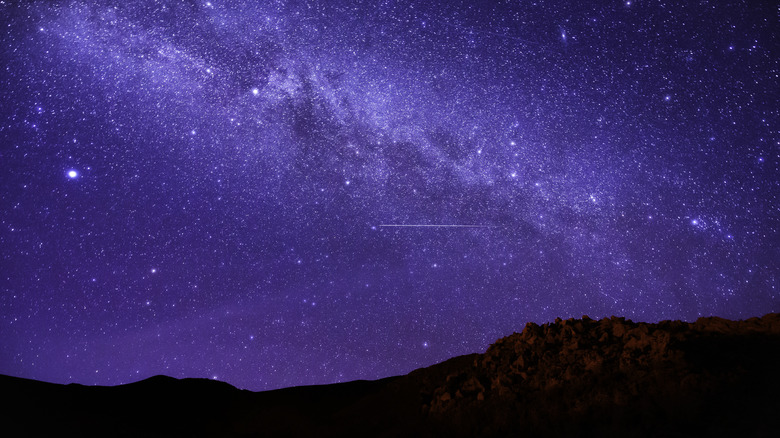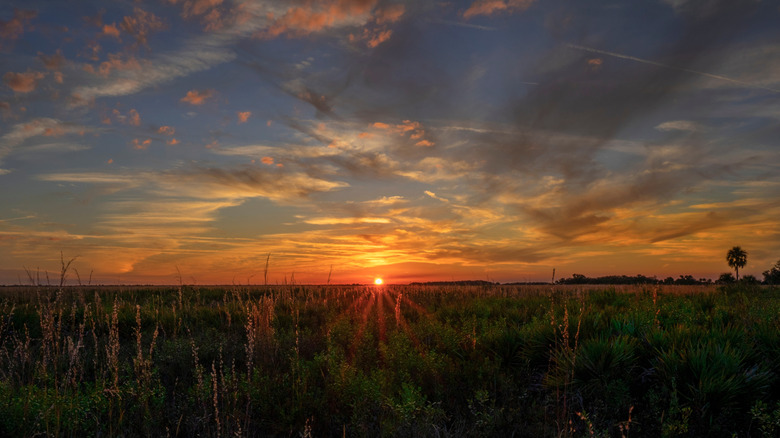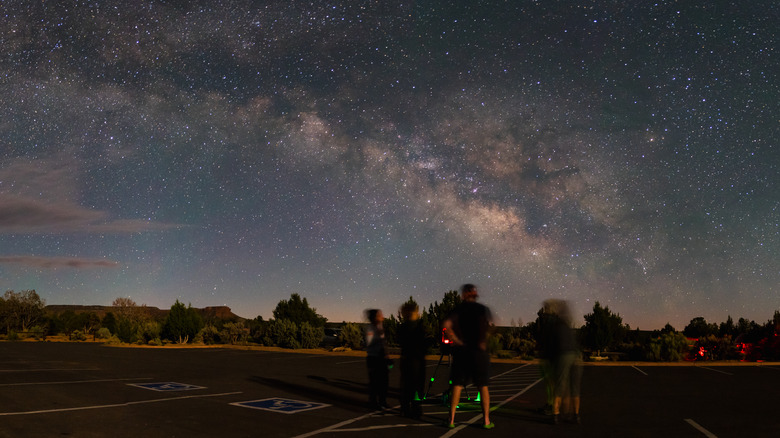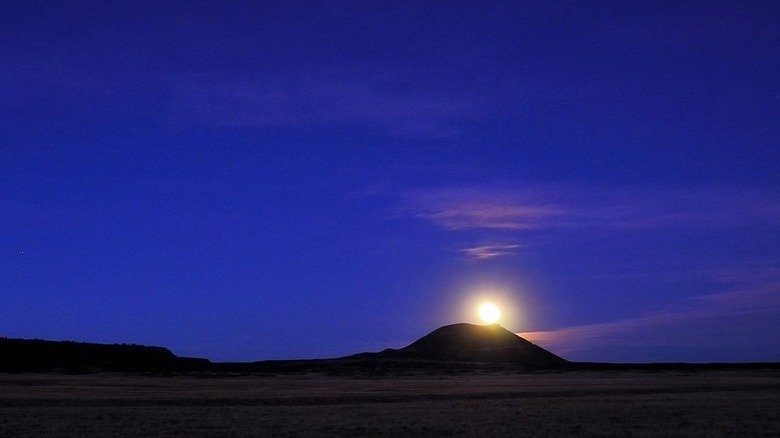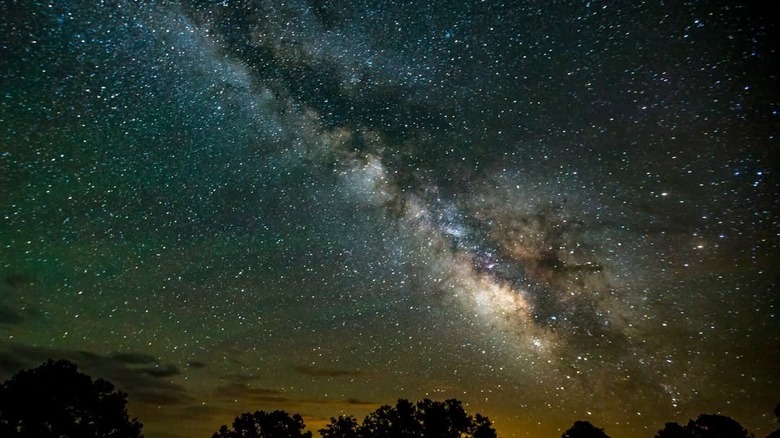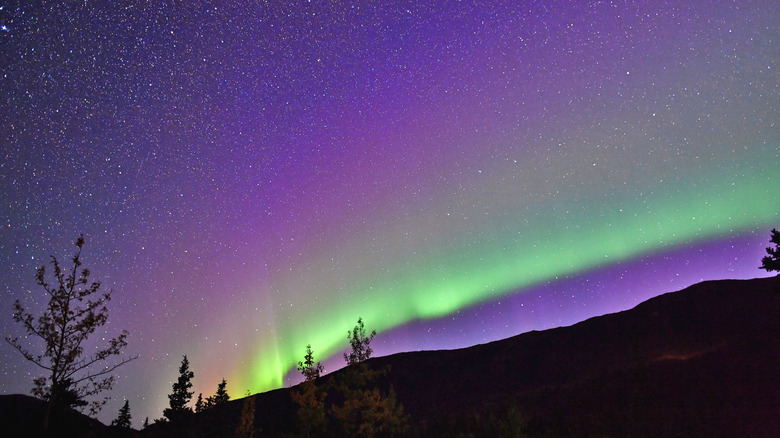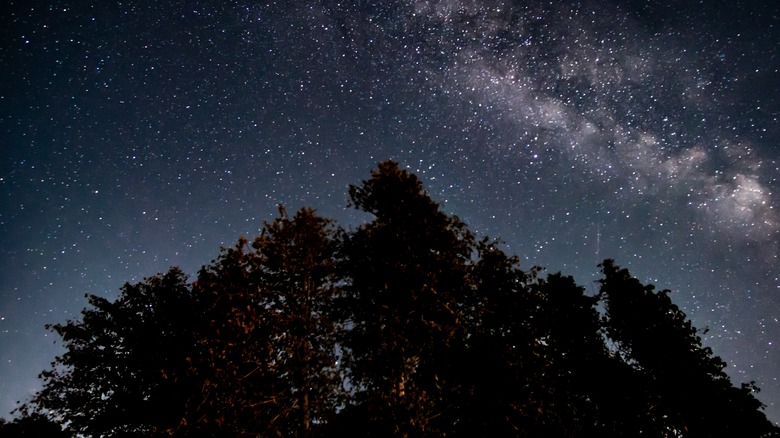The 13 Best Places In The United States To See The Milky Way
If, like many people in the U.S., you have an amateur interest in astronomy, you may looke to the skies regularly, trying to pinpoint the evening star, or work out where Orion's Belt is. And the chances are, like most of us, you have never truly been able to see much. A huge percentage of people can't see the Milky Way galaxy, and according to the Light Pollution Science and Technology Institute, at least 80% of Americans live under skies that are too polluted by artificial light to see any meaningful part of the galaxy. As depressing a thought as this is, it means that Milky Way enthusiasts can have a truly transformative experience if they manage to find a spot somewhere in the country that has reduced light pollution.
The Bortle Scale is used to classify areas based on how clear the skies are and how little light pollution there is. They range from Class 9, which is typical of urban areas and means seeing very little, to Class 1, the darkest skies in the country where the Milky Way can be viewed in all its splendor. Fortunately, there are many locations across the States that have been designated as official Dark Sky Places, many with Class 1 and Class 2 ratings. And in general, from volcanoes in Hawaii to Dinosaur Monument, Colorado, there are numerous beautiful locations across the country where the cosmos take center stage. Let's take a look at 13 of the best places in the United States to see the Milky Way.
Great Basin National Park, Nevada
To get the best possible stargazing experience, you should aim to visit a Bortle Class 1 site, and if you are in the Midwest, Great Basin National Park, Nevada, is an excellent option. As one of the least polluted sites in the U.S in terms of light pollution, you will get an excellent glimpse of our Milky Way and have a thoroughly great time in the process.
At Great Basin National Park, you won't be a lone star seeker, as they have plenty of organized programs for astronomy enthusiasts. In addition to ranger-led walks and constellations lectures, there is an annual astronomy festival, which is the perfect opportunity to surround yourself with like-minded star enthusiasts and immerse yourself in the dark sky.
If you're looking for an extended stargazing trip, there is a campsite that allows you to stay on site and no shortage of activities to keep you busy during the day. From hiking to exploring caves, days will pass quickly, leading you into the main event once the sun sets. During the astronomy festival, there are 'star parties' every night, allowing Milky Way enthusiasts to pitch up their telescopes and catch a glimpse of planets, clusters of stars, and even galaxies beyond our own. Whether you're a seasoned astronomer or looking for your first Dark Sky experience, Great Basin National Park in Nevada is one of the best places in the U.S. to observe the Milky Way.
Cherry Springs State Park, Pennsylvania
If you live in the eastern U.S. and thought that you'd need to travel to the west coast to get a good glimpse of the Milky Way, think again. Cherry Springs State Park, Pennsylvania, is one of the darkest places in the North East, and it has been designated as a Gold Level Everywhere Dark Sky Park, with Class 2 Bortle skies.
The 82-acre state park takes its role as a Dark Sky Park seriously, and every year, they host a sell-out Star Party during the month of June. For a truly unforgettable experience, camp overnight in the observing field, which is 2,300 feet above sea level. If you're lucky, you could catch a glimpse of Venus, one of the brightest objects in the night sky, the Omega Nebula, and other objects in space that aren't stars, thanks to the 360-degree views of our galaxy. Since all white light in the park is gone and has been replaced with red, there is a total lack of light pollution for miles, allowing you to get one of the best stargazing experiences in the east of the country.
Big Bend Ranch, Texas
If you're living in or heading to Texas and looking for some quality astronomy opportunities, head to Big Bend Ranch. As the only Bortle Class 1 Dark Sky Park in the state, it offers some of the clearest night skies in the whole country. Big Bend Ranch is Texas' largest state park, and their website describes the park as "the other side of nowhere," meaning that there is no light pollution from nearby cities.
If you're looking to make a trip to Big Ben ranch an event into one you will never forget, there are plenty of opportunities to do so. With backcountry campsites, you might feel like you're the only person on the planet, and there's even night time horseback riding if you're feeling adventurous. If you're visiting as a group, there's even the opportunity to rent the observatory with an elevated sky deck. This will allow you to see the Milky Way like never before, and take full advantage of the dark skies the park offers. A trip to Big Bend Ranch in Texas is the perfect opportunity to get away from it all and indulge in a little amateur astronomy like you've never seen before.
Mount Rainier National Park, Washington
The wet, foggy weather of the Pacific Northwest means it's probably not the first area to jump to mind when you think of clear, starry skies. However, given the right weather circumstances, Mount Rainier National Park in Washington state is a fantastic place to catch a glimpse of the Milky Way. Some sections of the park have skies classified as Bortle Class 2, meaning the chances of seeing some cosmic activity on a clear night are pretty high.
Mount Rainier National Park has plenty to do besides stargazing, so you will be able to occupy yourself during the day before settling in with your telescope to gaze at the beautiful, clear skies above. Mount Rainier itself is an active stratovolcano, meaning you get to enjoy the Class 2 dark skies in the shadow of this amazing 14,000-foot natural wonder.
If you want the benefits of expert astronomical advice during your trip, there are dark sky rangers available to talk you through what you see in the skies above and answer your cosmic questions. As long as you check the weather forecast before heading off, a trip to Mount Rainier National Park, with its views of the Milky Way, will be an adventure well worth it.
Mauna Kea, Hawaii
Gazing at the stars from ground level is all very well, but seeing the Milky Way from the top of an active volcano? Surely that would be an unforgettable experience. Mauna Kea in Hawaii is the state's tallest volcano, and the skies above just happen to be classified as Bortle Class 1, meaning you can combine a breathtaking trip up the mountain with a dazzling view of our solar system.
Viewing the stars from a height of almost 14,000 feet is an experience that simply can't be matched. Mauna Kea is considered one of the best places for stargazing on the entire planet, so if you have a chance to visit this extraordinary site, you definitely shouldn't give it a miss.
Of course, with conditions like this, Mauna Kea is certainly not restricted to amateur stargazers. Some of the most advanced observatories in the world can be found on the slopes of this volcano, and the visitor station is located roughly two thirds of the way up at 9,200 feet. Here, you will find viewing stations set up for amateurs with telescopes that will allow you to catch a glimpse of a nebula, shooting star, or even one of the visible planets. If this sounds like a heavenly adventure, you'd better book fast as spaces are incredibly limited. And remember, climbing to this sort of height is a challenge in itself, so you should only plan a trip to the beautiful extraordinary Mauna Kea if you are physically fit enough to do so and willing to prepare appropriately before you go.
Kissimmee Prairie Preserve, Florida
Florida may not seem the most obvious part of the United States for stargazing in dark skies, but Kissimmee Prairie Preserve isa surprising find that contains the darkest night skies in the Southeast. With Bortle Class 2 skies in the park, you have a very good chance of spotting some asteroids, nebulas or various other cosmic happenings.
Kissimmee Prairie state park is an especially brilliant option if you're looking to combine your stargazing exploits with a few days in the wilderness. Camping is available to book in advance, meaning you can hike or bike during the day before settling down with your telescope to see what the heavens have to offer you.
Far from the chaos of theme parks, this recognized Dark Sky Park is certainly a gem of a location to get in some serious star gazing, if live in — or are visiting — the Southeast.
Natural Bridges National Monument, Utah
Utah is known for its stargazing opportunities, hosting the most official Dark Sky Parks in the U.S. Natural Bridge's National Monument was the world's first ever official International Dark Sky park, making it the original stargazing location that kicked off the movement to reduce pollution in our skies. The website claims up to 15,000 stars can be seen at Natural Bridge's National Monument, compared to only 500 stars in an average city location. The remoteness of Natural Bridges and the effort to reduce white light where possible means that your eyes will have a chance to adapt to the dark and take in as many of the beautiful constellations above your head as possible.
Activities at Natural Bridge's National Monument are not limited to the evening with hiking opportunities during the day and more than 200 species of birds for you to spot. The campground close to the visitor center means that you can turn your astronomy opportunity into a short break and make the most what this stunning landscape has to offer.
Park rangers give out expert advice twice every week, meaning that this is a stargazing hot spot for both beginners and seasoned amateur astronomers alike. If you're looking to add a new Milky Way hunting spot to your list, you may as well choose the one that started it all.
Capulin Volcano National Monument, New Mexico
If you are looking for an interesting spot in the Southwest for some amateur astronomy, Capulin Volcano National Monument in New Mexico needs to be on your list. The landscape of this national park is breathtaking, with views of distant mountains, proximity to three other states, and of course the volcano itself. More than 6,000 feet in height, the extinct volcano makes an impressive surrounding for this particular stargazing location.
Having been a Gold Tier Dark Sky Park since 2016, Capulin Volcano is the perfect location to gaze at the Milky Way, especially in the summer months. You can bring your own equipment, or borrow the telescopes that are available at the park. There are opportunities throughout the summer to take part in ranger-led moonlight walks, to learn more about the fascinating extinct volcano, its surroundings, and of course the highlights of the night sky. At this Bortle Class 2 site, the clear skies and low light pollution mean you have an excellent chance of spotting some stellar activity.
Death Valley National Park, California
For a unique look at the Milky Way, Death Valley National Park in California offers many experiences that cannot be replicated anywhere else in the States, and with a Class 1 Bortle rating, there are plenty of opportunities to see the best of our skies.
The park is far from the intrusive lights of neighboring cities, and many people have worked hard to reduce light pollution within the park itself, which has led to its Gold Tier status. The National Park Service claims that there are objects in the heavens visible at Death Valley that cannot be seen anywhere else on the planet. They also offer tips for making the most of your trip, which include visiting during the new moon, to see that sky at its darkest possible point; giving your eyes at least 30 minutes to tune in to the darkness and really appreciate the sky; and to bring a red light with you rather than a regular flashlight, as the white light will have a negative effect on your ability to see the stars clearly.
Death Valley National Park is one of the ultimate locations in the country to view the Milky Way, and with plenty of events throughout the year and the Dark Sky Festival in spring, there are plenty of reasons to make the trip to Southern California to see our galaxy at its most impressive.
Observatory Park, Ohio
The Midwest isn't exactly furnished with dark skies in the same way as other parts of the country are, but you can still find some excellent stargazing spots if you know where to look. Observatory Park in Ohio is one of few Dark Sky Parks in the state, and it is an excellent spot for some celestial viewing.
The park is thoughtfully set up for some serious sky watching, and there are numerous high-powered telescopes you can use to get a better view. The park has a Class 3 Bortle rating, meaning you will be able to see the Milky Way much more clearly than in an urban area. There are many formal events throughout the year to help you make the most of the dark skies, including tracking asteroids and full moon hikes during certain months. It may not be the darkest park in the country, but Observatory Park in Ohio gives those living in the Midwest the opportunity to see the stars without traveling halfway across the country.
Dinosaur National Monument, Colorado
The west of the country is usually the place to head if you want to see the darkest skies on the mainland, and Dinosaur National Monument, Colorado, does not disappoint. Located on the border with Utah, which is also known for its amazing clear skies, you will be hard pressed to find darker skies than this Class 1 site. The high elevation and lack of light pollution will allow you to gaze at the heavens in wonder.
As you would expect, the National Monument goes to great lengths to protect the skies above, and low pollution lighting has been installed throughout the park. In addition to exploring the area on your own, you can join the ranger-led programs to gain some valuable astronomy insight from the experts on site.
If you fancy extending your trip into a short stay, the title of Dinosaur National Monument doesn't disappoint. You will find 1,500 exhibits in the Quarry Exhibit Hall, so you can spend your days at one of the best places to go looking for fossils, and then spend your nights celebrating the stars.
Denali National Park, Alaska
Viewing the cosmos from the American mainland can be wonderful, but if you have the chance to do so in Alaska, you will experience some breathtaking views. With much less light pollution than the majority of the country, Class 1 skies are in abundance, and Denali National Park is an ideal location to immerse yourself in them.
While the best stargazing is usually in the summer months elsewhere in the country, Alaska's northerly position makes things slightly different. The national park service recommends that six weeks either side of the summer solstice will not be the optimum time of year to see dark skies, due to the long summer days. Instead, fall to early winter is a better time, and you may have the chance to see the Northern Lights, too, if you are lucky.
A trip to Denali National Park is not just about the stars, and there will be plenty to do during daylight hours. Caribou, moose, and black bears can all be spotted in the park, and there is plenty of space to enjoy some hiking. Narrated bus tours are also an excellent way to spot some exciting animals and learn about the area at the same time.
Headlands International Dark Sky Park, Michigan
For a stunning view of the cosmos across the glistening waters of Lake Michigan, take a trip to Headlands International Dark Sky Park. The park is located in Emmet County, and there are regulations throughout the county to keep light pollution to a minimum, resulting in the Class 2 skies above the Dark Sky Park.
Located on the edge of the second largest Great Lake, the park offers uninterrupted views to the galaxy, and it also puts on regular astronomical events to keep visitors entertained and informed. There are accommodations available for avid sky watchers to rent, and plenty of natural beauty to admire during sunshine hours, including the Frog Pond Trail and the lake itself. If you are planning a trip to Headlands, just be sure to bring your red flashlight to ensure you don't impose artificial light on their beautiful dark skies.
